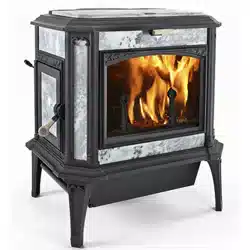Loading ...
Loading ...
Loading ...

CATALYTIC
COMBUSTORS
Here is how your catalytic combustor works.
The catalytic combustor is a stainless steel honeycomb with hundreds of cells. If you looked at the
inside of each cell with a microscope, you would see that the walls are uneven and filled with minute
nooks and crannies. Precious metals, such as platinum, are sprayed on the inside of these cells to coat all
of the nooks and crannies. This creates the largest possible surface area to interact with the wood smoke.
The catalytic combustor in your stove is very similar to the one in the exhaust system of your automobile
and works to achieve the same results - high efficiency and clean air!
When you first start a fire, you should bypass your catalytic combustor and let the smoke go directly
up the chimney. Once wood smoke reaches 500º F (about 10-15 minutes after re-establishing a strong
fire), it is hot enough to ignite the catalytic combustor. As the wood smoke passes through the cells in
the combustor, the smoke reacts with the precious metals which line the inside of the honeycomb and
both combustible gases and particles in the smoke ignite and burn. This “catalytic burn” reduces
emissions and also increases heat output from the stove.
Without a catalytic combustor, between 5% - 40% of the chemical energy contained in wood simply
escapes up the chimney when wood is burned. Energy laden gases are exhausted up the chimney where
they pollute the air or may condense on the inside of the chimney flue as creosote. The slower the burn,
without a catalytic combustor, the greater the amount of energy that is lost. A long smoldering fire is the
least efficient use of energy in wood, yet it produces lots of smoke, which is the fuel supply for the
catalytic combustor.
Most of the chemical compounds in wood smoke are combustible. The catalyst produces high
temperatures, which loosen the bonds of these chemical compounds and “burns” wood smoke. A stove
that “burns” these compounds and uses smoke as additional fuel will burn more efficiently and produce
more heat, while reducing creosote and air pollution at the same time. However, most stoves cannot
consistently produce temperatures high enough to burn cleanly, particularly during long burning times -
hence the need for a catalytic combustor.
Your catalytic combustor can get the most efficiency out of every piece of wood if it has three things:
temperature, turbulence, and time.
1. Temperature. The catalytic combustor can only start burning the gases in the wood smoke after the
smoke has reached at least 500 degrees F. Before the smoke reaches that temperature, it simply is
not hot enough to start the reaction at the combustor. This will result in an inefficient smoldering fire.
2. Turbulence. The wood smoke can interact best with the precious metals inside the honeycomb cells if
there is some variation in the air flow. Increased turbulence enables more of the wood smoke to
come into contact with more of the nooks and crannies in the honeycomb cells. The exhaust path as
well as the irregular surface of the combuster cells adds needed turbulence.
3. Time. Once the temperature and turbulence are achieved, the catalytic combustor just needs to have
enough time to burn all the gases in the wood smoke. For this reason, it is best to minimize the
amount of air you allow into the firebox once the combustor is ignited. Allowing too much air into
the firebox speeds up the rate at which the fire burns and allows more wood smoke to be consumed
by the secondary combustion system . The ideal air setting for a long catalytic burn allows enough
air to keep the wood burning and producing smoke.
With proper care, a new catalytic combustor will give years of fuel savings and lowered emissions.
By following some simple guidelines you can ensure maximum combustor performance and longevity.
Your catalytic combustor is designed to last for 12,000 -14,000 hours of use. You can ensure yourself of
getting the maximum life from your combustor by following these simple guidelines:
21
Loading ...
Loading ...
Loading ...
